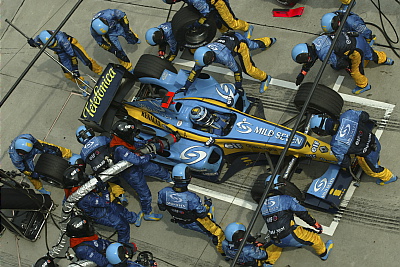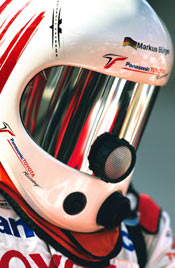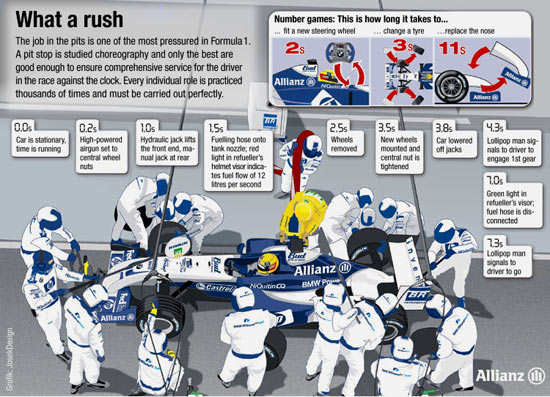Pit stop
The job in the pits is one of the most pressured in the world of Formula One. Pit stops have become more and more important over the last years. Since overtaking moves are rarer than ever, pit stops have become the prime opportunities to gain places. A pit stop, though, is never as easy as it looks. For seven seconds, if all goes well, the drivers' changes in the race are in the hands of his pit crew.
Pit stop guide
Step 1 The driver enters the pit lane at full speed but brings the speed down to the pit lane speed limit of 80km/h (60km/h in a very tight pit lane, like in Monaco). As he crosses the pit lane line, he engages a pit lane speed limiter that electronically prevents the car from accelerating above the speed limit. Selecting the limiter, the fuel filler flap automatically pops open. The driver has to stop exactly on the marks painted on the pit lane so the mechanics lose no time repositioning themselves. When the car stands still, the driver sets it in neutral and keeps his foot on the brake so that the wheels don't turn as the wheel nuts are spun loose.
Step 2 The car is lifted up onto its jacks as the mechanics remove the wheels and the fuel hose is attached.
Step 3 As the fuel is going in, new wheels are attached and the mechanics raise their arms in the air to show they have finished.
Step 4 As all the four wheels have been changed, the car is lowered to the ground and the last fuel is pumped in. The driver is shown a board (the lollipop) telling him to engage first gear.
Step 5 The fuel hose is detached and the car is ready to go.
Step 6 The driver is waved away by the lollipop man. As the car is leaving the pits, the fuel flap automatically closes if the driver again pushes the speed limiter button.

These six steps may seem easy but need to be executed in only 7 seconds.
Pit crew and their duties
Lollipop man
The first job of the lollipop man is to guide the incoming car to the exact stopping point by lowering the 'lollipop' to a stop position right in front of the driver's helmet. When the four wheels have been changed, the lollipop man has to signal the driver to engage first gear.
The lollipop man can only lift the lollipop if he's sure that all the four wheels have been attached, the refuelling is completed and there isn't another car to be in the driver's path.
Front Jack The front jack operator raises the car as soon as he's sure the car is in the right position to allow the fuel nozzle in. If there has been an accident and the nose section needs changing, it is his job to remove the broken one.
The jack, the front jack operator uses to lift the car into the air, is made from steel tubing and has a quick-release button to bring the car back down. Because the teams have different nose cones giving different aerodynamic characteristics, they need to have specific jacks to suit them.
Rear Jack The rear jack man has to wait until the car has passed him before getting into position. He then places his jack beneath the car and raises the rear of the car.
Wheel changing crew Each wheel has two to three crew members. One operates the compressed air-driven gun that removes the single, central retaining nut. Then one of the other mechanics removes the old wheel and one fits the new one. The gun man then re-attaches the nut and tightens it to around 500 lb/ft (pounds per foot).
Refueller
The refueller is supported by two other crew members. He has to lift a heavy nozzle over his shoulder and get it into the tank the moment the car arrives. The refueller handles the hose itself and another crew member presses on the 'dead man's handle' which has to be kept down in order to fuel the flow. As soon as the handle is released, the fuel stops flowing.
The rig delivers 12 litres of high-octane fuel a second.
The rig is standardised and provided by the governing body, the FIA, to the teams who are not allowed to modify it in any way. Attached either to the hose or to the refuellers' helmets are indicators showing when the fuel is flowing and when the process is completed. As soon as these indicators tell the refuellers that the car is full-up, they release the latch that holds the nozzle to the filler and then use a second handle to release the nozzle from a connector on the car. Overseeing the whole operation are two crew members, each with a 60-liter fire extinguisher. Larger capacity fire hoses are at hand in the garage. An additional safety feature on the fuel rig are earthing strips that are wired to the refuelling rigs and reduce the chances of static electricity discharging — highly undesirable with all that fuel around.
Extra crew members Extra crew members are placed at the sidepod entrance to reach in and remove debris from the radiators to prevent overheating and engine failure. There may also be a crew member to clean the drivers visor during the pit stop.
Interview with Renault’s Chief Mechanic, Gavin Hudson
What is exactly your job during a pitstop?"I look after the lollipop which is basically the car control. During a pitstop I have to make sure that the wheels are all changed, the tyres and that the fuel is done and make sure the front jackman is out of the way before I let the car go."
So it's a lot of pressure for you because you have to manage lots of things..."There are lots of things to look at in just 6 seconds, yes."
What are the main tricks to do a quick pitstop?"It's just that everything has to go smoothly and basically, for the wheels to be changed properly the nozzle to go on quickly and come off quickly. And just make sure the track is clear when you let the car go."
How many times to you practice during a GP weekend?"We will probably practice 25 times on Friday morning and practice again on Sunday morning to do another 20-30 practices and then we do that at every race."
What kind of practice do you make?"We practice almost every scenario that may happen during the race. We do standard refuelling/tyres, we do nose changes, we will practice the rig failing when the refuelling rig is having a problem, we practice if we have a problem with the clutch and we have to drop the car down onto the ground, if we have to lift the car up in the air, we practice all the sorts of things that could possibly happen during the race."
Do you also practice with the drivers to make sure they know what to do during the race?"Yes sometimes we do. I mean they will do that during the session on Friday and they will do it again during the free practice session on Saturday. We do stops just to make sure they know where to stop in the box and stuff like that.
What are the main risks that may happen during a pitstop"The main risk is when the nozzle has been left and you are not disconnected. You can also have a fire if there is a problem with the nozzle, you can have stuck wheel. There are many different things that can happen so we just hope that nothing goes wrong."

Pit crew clothing
The clothes of the pit crew are very much like the oufit of the drivers. All the pit crew members wear a balaclava and a helmet. They also wear a suit made of lightweight Nomex fibre to protect them from fire.
Danger of a pit stop
A pit stop is not without danger. It wouldn't be the first time that a car caughts fire while being in the pits. The job of front jack operator isn't without danger as well, as the car is approaching the crew at 50km/h.
Being part of the pit crew is one of the most exciting parts of a race team. It is also potentially one of the most hazardous. The mechanics get no danger money and it’s almost impossible for them to find life insurance. Yet few would swap their job in the pit lane for anything else.
Special thanks to Renaultf1 for the interview and to Allianz for the drawing
